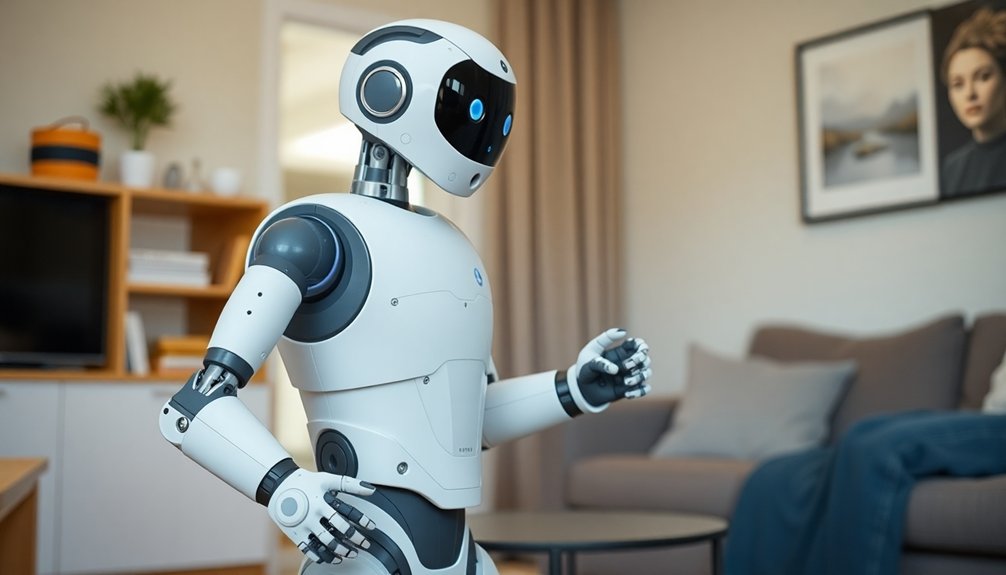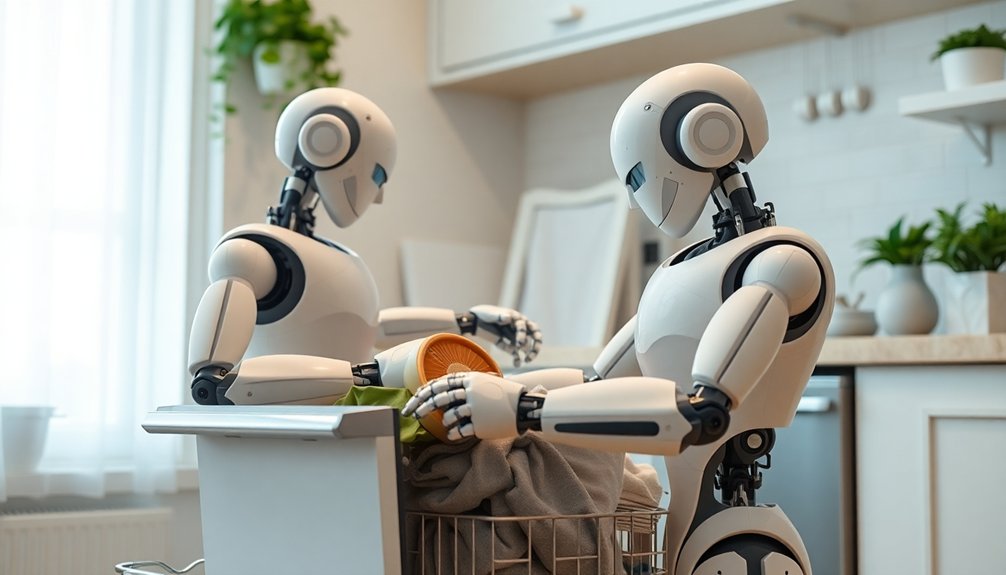Table of Contents
We’re tantalizingly close to robots that can actually help around the house—but think “enthusiastic intern” more than “robotic superhero.” Current prototypes can fold laundry, make coffee, and navigate spaces with about 85% accuracy. Companies like Figure are targeting home-helper bots by 2025, promising to transform tedious chores into push-button experiences. Want to see how these mechanical helpers are getting smarter? Stay tuned.
The Current State of Home Robotics Technology

While we’ve long dreamed of robotic helpers straight out of sci-fi, home robotics technology is finally graduating from fantasy to functional reality.
Samsung’s Ballie robot at CES 2025 isn’t just another shiny gadget—it’s a glimpse into a future where robots might actually earn their keep around the house.
We’re seeing smart machines that can connect to home systems, respond to voice commands, and potentially handle real tasks. Enabot’s versatile design shows how home monitoring robots can patrol spaces and interact with pets simultaneously.
Neuromorphic computing innovations are rapidly enhancing robots’ ability to learn and adapt to complex home environments.
Sure, we’re not quite at the fully capable robot butler stage, but we’re getting closer. AI market expansion is driving rapid innovation in home robotics, with projected growth to over $50 billion by the mid-2020s.
Imagine a device that can monitor your home, adjust settings, and maybe even help with laundry.
The tech isn’t perfect, but it’s rapidly evolving.
Are we on the cusp of a robotic revolution, or just another overhyped tech trend?
Only time will tell.
Physical Capabilities and Navigational Intelligence
We’ve watched robots stumble and bumble through homes for years, but now they’re getting seriously good at moving around without knocking over Grandma’s precious china. Robotic companies like 1X Technologies are developing humanoid robots with advanced sensor networks that can dynamically map and interact with complex home environments. Their ability to recognize objects and map spaces has jumped from “cute but useless” to “actually pretty impressive” – imagine a robot that can spot your lost TV remote before you’ve even started looking. Machine learning algorithms are continuously refining these robots’ perception capabilities, allowing them to process sensory inputs from multiple sources like cameras, LiDAR, and tactile sensors. With advanced sensors and AI, these mechanical helpers are transforming from clunky prototypes into something that might genuinely make our lives easier, even if they’re not quite ready to replace human hands just yet. Safety challenges in unpredictable home environments mean these robots must develop robust navigation algorithms to truly become household assistants.
Robot Movement Precision
Precision is the heartbeat of humanoid robotics—and movement is where the magic happens.
We’re talking about robots that can dance through complex environments without tripping over their own feet. By capturing human movement data with laser-like accuracy, these mechanical helpers are learning to mimic our motions down to the tiniest twitch.
Imagine a robot that can fold laundry as smoothly as your grandma, or navigate a cluttered kitchen without knocking over a single coffee mug. Optical sensors enable these robots to transform from blind metal creatures into precision-seeing digital navigators that can detect obstacles with remarkable sensitivity.
It’s not perfect yet—these machines still stumble occasionally—but we’re closer than ever to having a robotic helper that moves like a pro. Technologies like motion capture data are enabling robots to learn increasingly sophisticated movement patterns through precise human-like training techniques.
Companies like Honda and Toyota are pioneering advanced robotic mobility that demonstrates the potential for humanoid robots to perform complex physical tasks with remarkable precision.
Object Recognition Skills
If robot navigation were a video game, object recognition would be the ultimate boss level—complex, unpredictable, and totally game-changing. Our robots are getting seriously smart, with 98.7% object detection accuracy that’s close to mind-blowing. Check out how they’re leveling up: Advanced AI sensor technologies are rapidly transforming how these robotic systems interpret complex environmental data. Robots like Alter 3 are pioneering neural learning pathways that allow them to comprehend spatial relationships with unprecedented precision. Convolutional Neural Networks can decode sensor data with remarkable speed, transforming chaotic point clouds into navigable 3D terrain.
| Skill | Performance |
|---|---|
| Object ID | 98.7% Accurate |
| Task Adaptation | Minimal Pre-Programming |
| Environment Reading | Real-Time Scene Understanding |
These machines can now scan a kitchen and know exactly where your coffee mug sits, distinguish between a cat and a throw pillow, and even predict potential hazards. They’re learning faster than your teenager learns TikTok dances. But here’s the catch: that 1.3% error rate means they’re not quite perfect. Close? Definitely. Ready to replace humans entirely? Not yet. But we’re getting there, one recognized object at a time.
Home Space Navigation
Since home robots aren’t just sci-fi fantasies anymore, maneuvering domestic spaces has become the ultimate technological challenge.
We’re talking about machines that need to dodge kids’ toys, weave around pets, and handle everything from plush carpets to slippery tiles. Neuromorphic computing technologies are enabling robots to process sensory inputs with incredible speed, dramatically improving their ability to analyze and respond to complex home environments. Our current robot prototypes can track hundreds of moving objects simultaneously, but they’re still learning the home’s chaotic dance. LiDAR and camera integration enables robots to scan and interpret complex home environments with unprecedented spatial awareness.
Industrial spaces? Easy. Your living room? That’s a navigation nightmare. With 83% obstacle avoidance in simulations, we’re close—but that pesky 17% failure rate means robots might still abruptly stop or crash into your grandmother’s antique vase.
The Figure Helix VLA model is our secret weapon, training robots to interpret home environments like seasoned explorers, turning domestic navigation from impossible to impressive. NEURA Robotics’ latest cognitive processing allows these robots to develop adaptive learning strategies, potentially bridging the gap between robotic precision and home environment complexity.
AI-Driven Interaction and Learning Potential
When we talk about robots that can actually understand and interact with humans, we’re not just dreaming about sci-fi anymore—we’re looking at real technology that’s changing how machines communicate.
These AI-powered helpers are getting seriously smart, with capabilities that’ll make your jaw drop:
- They can recognize your emotions and respond accordingly
- They understand complex verbal instructions like a patient assistant
- They learn your preferences and adjust their communication style
Imagine a robot that doesn’t just hear you, but genuinely comprehends what you’re saying.
We’re talking about machines that can pick up on subtle context, crack a joke, and even anticipate your needs before you articulate them.
Sound impossible? Not anymore. The future of home assistance is here, and it’s smarter than you think.
Real-World Testing and User Experience

From understanding robot emotions to actually seeing them work in our homes, we’ve moved from sci-fi fantasy to real-world beta testing.
Our early humanoid helpers aren’t perfect, but they’re surprisingly promising. Imagine a robot that can carry groceries, make coffee, and maybe even fold your laundry—with only a few hilarious mishaps.
These machines are learning through actual home deployments, testing their limits in unpredictable environments. Neo and similar robots are proving they can handle simple tasks, complete about 85% of household chores, and even provide companionship.
They’re not replacing humans yet, but they’re getting closer. The magic is in their adaptability: watching them learn, adjust, and slowly become more like the helpful assistants we’ve always dreamed about.
Who knew the future would look so delightfully awkward?
Technological Challenges and Engineering Barriers
Although science fiction has long promised household robots that seamlessly blend into our lives, the engineering reality is far more complicated.
We’re battling massive technological hurdles that make building a genuinely helpful humanoid robot feel like solving a Rubik’s Cube blindfolded. The challenges are mind-boggling:
- Creating joints that move with human-like fluidity without breaking down after a week
- Developing AI smart enough to distinguish between a sock and a dish towel
- Designing safety protocols that prevent robots from accidentally turning your living room into a disaster zone
Precision engineering meets impossible expectations.
Where technological ambition collides with the razor’s edge of human imagination.
We can build machines that move, but can we build machines that genuinely understand? The gap between what we want and what we can deliver remains frustratingly wide — a reflection of just how complex human movement and interaction really are.
Projected Roadmap for Domestic Robotic Assistance

As we chart the course for domestic robotic assistance, the roadmap looks less like a straight highway and more like a winding mountain trail with plenty of unexpected switchbacks.
We’re seeing early glimpses of robots that might actually help around the house, but not without serious growing pains. Companies like Figure are betting big on home-helper bots, targeting alpha testing by 2025 with robots that can prep food, clean, and maybe even watch your kids.
But let’s be real: these aren’t sci-fi seamless companions yet. They’re more like enthusiastic but clumsy interns learning the ropes.
We’ll likely see warehouse and factory deployments first, with home use trailing behind as engineers wrestle with the chaos of domestic environments.
Baby steps, people.
People Also Ask
Can a Home Robot Protect My Belongings From Accidental Damage?
We’re making progress with advanced navigation and sensor technologies that help robots detect and avoid obstacles, minimizing potential damage to your furniture and personal items. However, complete protection isn’t guaranteed yet.
How Much Will a Household Helper Robot Cost Initially?
Like a shiny spaceship landing in our living room, household robots will initially cost between $10,000 and $30,000. We’ll see prices from companies like BYD and Tesla that aim to make these high-tech helpers increasingly accessible.
Will Robots Understand Complex Family Dynamics and Emotional Nuances?
We’re developing advanced AI systems to help robots comprehend emotional subtleties and family interactions. Our goal is creating empathetic machines that can navigate complex relational dynamics with sensitivity and intelligence.
Can Home Robots Handle Unexpected or Unusual Household Tasks?
We’re developing robots with advanced AI and sensors that can adapt to unexpected tasks, learn from interactions, and integrate with smart home systems, making household assistance increasingly flexible and intuitive.
How Safe Are Humanoid Robots Around Children and Pets?
We’re far from guaranteeing humanoid robot safety around children and pets. Significant risks include unintended physical harm, emotional attachment issues, and potential privacy breaches requiring extensive technical safeguards.
The Bottom Line
We’re not quite there yet, but robots might soon rescue us from domestic drudgery. While today’s machines can fumble through basic tasks, true home helpers remain a sci-fi fantasy. Sure, they’re getting smarter, but will they fold laundry without turning it into abstract art? Our robotic saviors are coming—just don’t expect them to replace your favorite cleaning playlist or solve all your chores. Stay tuned, and keep that broom handy.
References
- https://www.freethink.com/artificial-intelligence/humanoid-1x
- https://www.designboom.com/technology/humanoid-robot-neo-gamma-house-chores-home-owners-autonomous-assistant-02-26-2025/
- https://www.youtube.com/shorts/gE5qwlsyaVQ
- https://www.youtube.com/watch?v=hHA4-nEBer8
- https://revtechpartners.co.za/index.php/2025/01/28/hotel-robots-in-2025-the-role-of-automation-in-housekeeping-concierge-and-guest-services/
- https://www.ericjkuhns.com/blog/best-tech-i-saw-from-ces-2025-robots-ai-and-more
- https://leadertechinc.com/what-key-innovations-in-2025-are-driving-the-future-of-home-robots/
- https://www.youtube.com/watch?v=7zj-YGvp7TM
- https://blog.bccresearch.com/from-hospitals-to-homes-how-robotics-will-change-your-life-in-2025
- https://news.stanford.edu/stories/2025/03/soft-robotics-caretaking-home-robots
